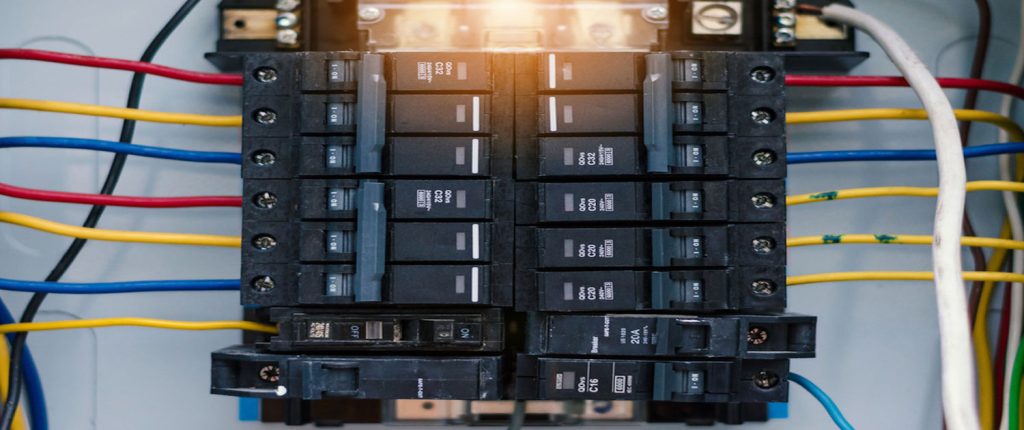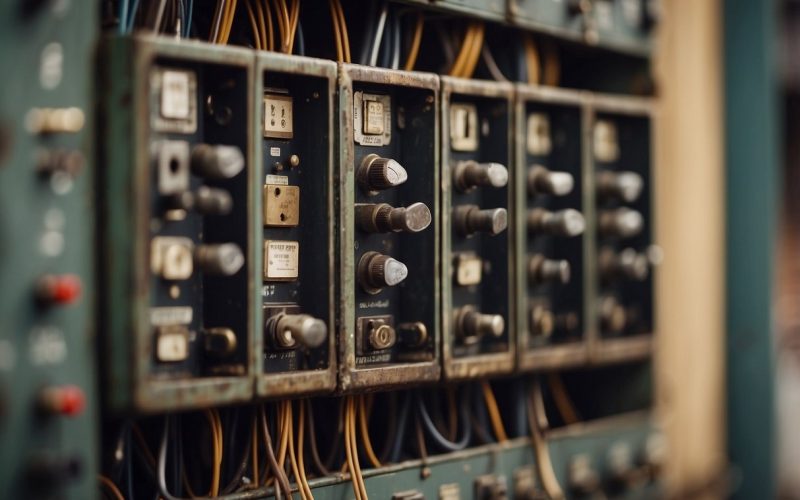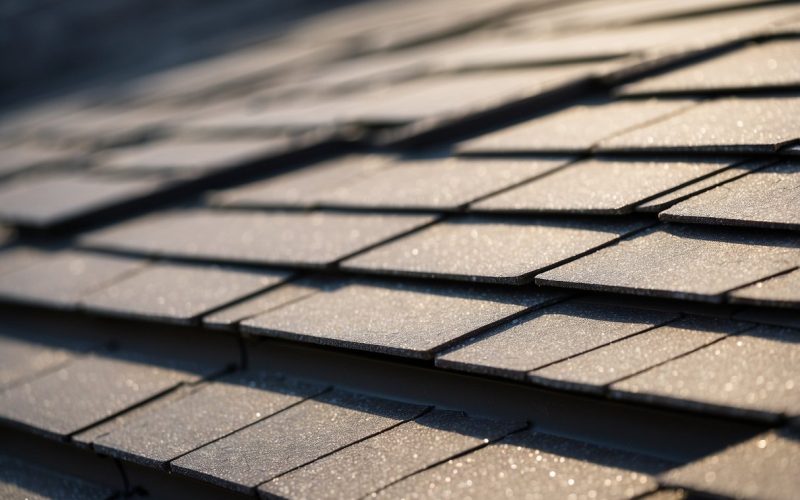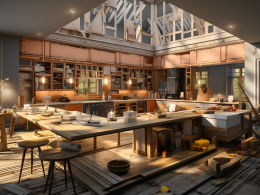Electrical panels, sometimes called breaker boxes, play a crucial role in home safety and maintenance. Old electrical panels can pose serious safety risks, including the potential for electrical fires. It’s important to know if your home has outdated systems that might need replacement.
Homeowners should check their electrical panels regularly to ensure they function properly. Scott Beetham, owner of Beetham Electric, warns homeowners that “The signs of worn-out panels include flickering lights, frequent breaker trips, or a panel that’s warm to the touch. Addressing these issues early on can prevent bigger problems and keep the home safe.”
Upgrading an old breaker box can also improve the efficiency of your electrical system. A modern panel can handle more electrical load, which is especially useful if you’ve added new appliances or electronics. Keeping your home’s electrical system up-to-date is a key aspect of home maintenance.
Understanding Electrical Panels

Electrical panels are crucial parts of any building’s electrical system. They distribute electric power and help protect the wiring and devices within the structure.
Types of Electrical Panels
There are several types of electrical panels, each with its own use. Fuse boxes are older and use fuses to protect circuits. Circuit breaker panels are more common today and use breakers that can be reset. These panels include the main breaker, which controls the power supply to the entire building, and individual circuit breakers for different areas or devices.
Some older brands and types to be aware of include Federal Pacific, Zinsco, and Challenger panels. These are often considered outdated and unsafe due to their tendency to fail and cause electrical fires. Modern homes typically use updated, safer versions.
Components of a Typical Panel
An electrical panel contains several key parts that work together. The main breaker is essential as it can shut off all power to the building. Circuit breakers or fuses are used to manage individual circuits, protecting against overcurrent.
A bus bar helps in distributing power to different breakers. Each circuit it serves is further protected by a grounding wire to prevent electrical shock. Some panels also include a neutral bus, which returns unused electricity to the ground.
Knowing these components helps in understanding how electricity is managed and ensuring overall safety.
Common Brands and Manufacturers
Some common and reliable electrical panel brands include Siemens, Square D, and Eaton. These brands are known for their safety and durability. Each offers different models to suit a variety of needs, from residential to commercial use.
Watch out for Federal Pacific, Zinsco, and Challenger panels in older homes. These brands have known safety issues and should be inspected by a qualified electrician. Modern replacements from reputable brands are often recommended to avoid risks associated with older panels.
Understanding these brands and what they offer can help in making informed decisions.
Signs You Need an Electrical Panel Upgrade
If your home is experiencing frequent electrical problems, it may be time to think about upgrading your electrical panel. Old or outdated panels can lead to various issues that might pose safety risks.
Age and Obsolescence
Electrical panels installed over 30 years ago might not meet current safety standards. Panels that are outdated may not handle the electricity demands of modern appliances and devices. Federal Pacific Electric (FPE) and Zinsco panels, for example, are known to be faulty and should be replaced.
Signs of an aged panel include rust, worn-out labels, or unusual sounds. If the panel feels warm to touch, it’s a strong indicator of obsolescence and hazards.
Frequent Breaker Tripping and Flickering Lights
A common sign of needing an upgrade is frequent breaker tripping. Modern electrical loads often exceed the capacity of old panels. Flickering lights can also indicate an overloaded or failing panel.
If breakers trip often or lights flicker when you use more than one device, it’s a good time to inspect the panel. Breakers that won’t reset are another red flag.
Evidence of Electrical Fires
If you notice a burning smell coming from your electrical panel, act immediately. This can signal overheated wires or circuits that pose serious fire risks. Look for scorch marks or melted insulation material around the panel.
These signs of past or potential electrical fires mean the panel is hazardous. It’s crucial to replace it to protect your home and family from fire dangers.
Safety Hazards of Old Electrical Panels

Old electrical panels can pose several safety hazards, including rust and corrosion, overheating and melting, and loose wiring and connections. These issues can lead to serious problems such as fire hazards and electrical failures.
Rust and Corrosion
Rust and corrosion can damage the metal components inside electrical panels. Moisture and humidity can cause these issues. When connections rust, the electrical current may not flow properly. This leads to overheating or sparking.
Corroded panels:
- Risk fire hazards
- May cause shocks
- Often fail to protect circuits
According to the Consumer Product Safety Commission, rust and corrosion are critical safety concerns.
Overheating and Melting
Overheating in old electrical panels can happen due to outdated components. Worn parts may not handle modern electrical loads. There is a risk of wiring insulation melting, which can lead to short circuits and fires.
Signs of overheating:
- Burning smell around the panel
- Discolored or melted wires
- Tripped circuit breakers
The National Fire Protection Association states that overheating is a leading cause of electrical fires in homes.
Loose Wiring and Connections
Loose wiring and connections in old panels can create gaps where electricity can arc. Electrical arcing can produce high heat and be a fire hazard. Panels with loose connections may also fail to supply power consistently.
Issues with loose connections:
- Flickering lights
- Unstable power supply
- Increased risk of fires
Ensuring tight connections is crucial for avoiding these risks. The National Fire Protection Association and Consumer Product Safety Commission highlight the importance of regular maintenance to avoid hazards.
The Electrical Panel Replacement Process
Replacing an old electrical panel involves several steps. A professional must inspect the existing panel, select the right replacement, and carefully install the new unit.
Initial Inspection and Assessment
The process begins with a licensed electrician inspecting the current electrical panel. They look for signs of wear or damage, such as burnt marks, rusty components, or faulty wiring.
During the inspection, the electrician determines whether a service upgrade is necessary. They check the home’s power needs and existing electrical system, ensuring all connections and breakers meet industry standards.
Permits are often required before starting the replacement. The qualified electrician will handle this, ensuring all paperwork is in order.
Choosing the Correct Panel Replacement
Next, the electrician selects the right panel for replacement. This involves considering the home’s electrical demands. They may suggest upgrading to a higher capacity panel if the current one is insufficient.
Material quality is crucial. The electrician will choose panels from reputable manufacturers, ensuring longevity and safety. Labor costs and material prices will factor into the electrical panel replacement cost.
It’s also important to ensure the new panel meets industry standards and compliance codes. This keeps the home safe and avoids future issues.
The Replacement Workflow
The actual replacement begins with turning off the main power supply. This is to ensure safety during the procedure. The electrician then removes the old panel, carefully disconnecting all wires and components.
Next, the new panel is installed. Wiring is reconnected, ensuring all connections are secure and properly aligned. The electrician then tests the panel to ensure everything is working correctly.
Finally, the work is inspected. This is sometimes done by another professional or a building inspector to ensure compliance with local permits and safety codes.
Bold or italics can help highlight important steps or items. For instance, always hire a licensed electrician for safety and compliance.
Additional Considerations for Panel Upgrade

Upgrading an old electrical panel involves more than just replacing parts. You need to consider modern electronics and appliances, compliance with building codes, and budgeting.
Upgrading for Modern Electronics and Appliances
Today’s homes often have more appliances and electronics than older electrical panels can handle.
Adding a new electric vehicle, heat pump, or HVAC system requires more power. Older panels may not provide sufficient amperage.
Modern kitchens with multiple high-wattage appliances like ovens, microwaves, and dishwashers need an upgraded panel to run safely and efficiently.
Building Codes and Legal Requirements
Upgrading an electrical panel must meet current building codes to ensure safety.
Building codes vary by location, so always check local regulations. Permits are usually required for panel upgrades, and the work must pass inspection.
Insurance companies might require proof that upgrades meet these standards, impacting the approval of your policy or claims.
Cost Factors and Budgeting
Several factors influence the cost to upgrade an electrical panel:
- Materials: Cost of the new panel and additional components.
- Labor: Professional installation fees.
- Permits and Inspection: Fees for obtaining necessary permits.
- Drywall Repair: Fixing any wall damage after installation.
- Subpanel Addition: Adding a subpanel if extra circuits are needed.
Budgeting is crucial; consider long-term benefits like increased safety and the ability to add more appliances.
Frequently Asked Questions
Old electrical panels can pose various issues, including safety risks and non-compliance with current electrical codes. Below are common questions related to old electrical panels.
What are some common types of old electrical panels that may need updating?
Some common types include fuse boxes, Federal Pacific Electric (FPE) panels, and Zinsco panels. These panels may not meet current safety standards and often require updating.
Can old electrical panels with fuses still meet current electrical codes?
Fuse boxes generally do not meet current electrical codes. Modern standards typically require circuit breakers, which are safer and more efficient.
How does one identify the brand of an old electrical panel?
The brand can usually be found on the inside of the panel door or on the circuit breaker labels. Sometimes, the brand name is also molded into the cover.
What are the safety concerns associated with old electrical panels?
Old panels might have worn-out components, loose connections, and outdated technology. These issues can lead to electrical fires, shocks, and system failures.
How can homeowners determine the age of their electrical panel?
The age can often be determined by looking at the labels or stamps inside the panel, which may include manufacturing dates. Electrical inspection reports might also provide this information.
Are there specific brands of electrical panels that are known to have issues?
Federal Pacific Electric (FPE) and Zinsco panels are known to have significant safety issues. These brands often fail to trip during an overload or short circuit, leading to potential fire hazards.











